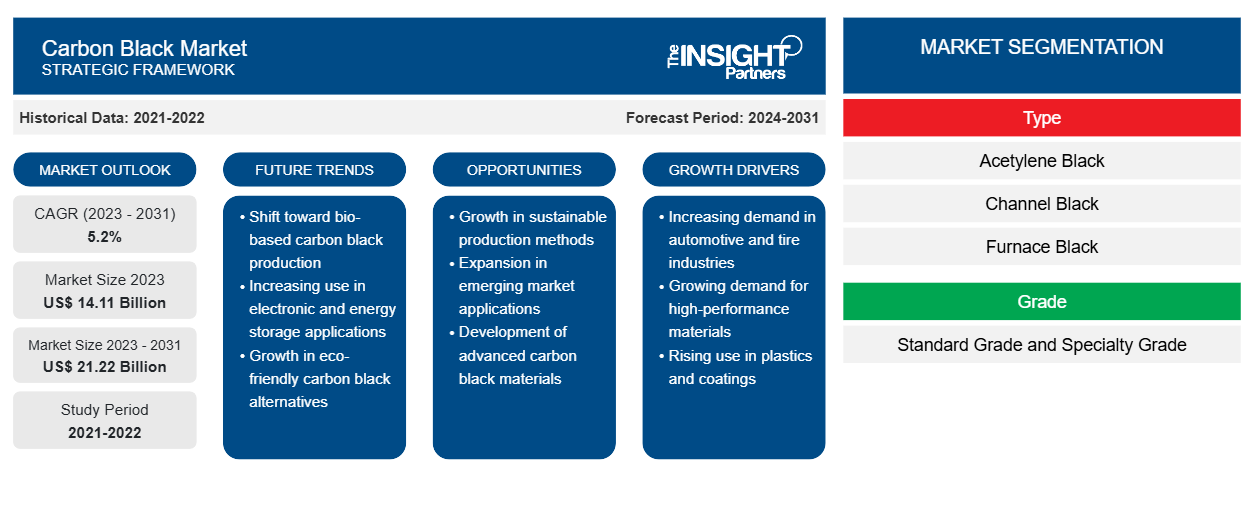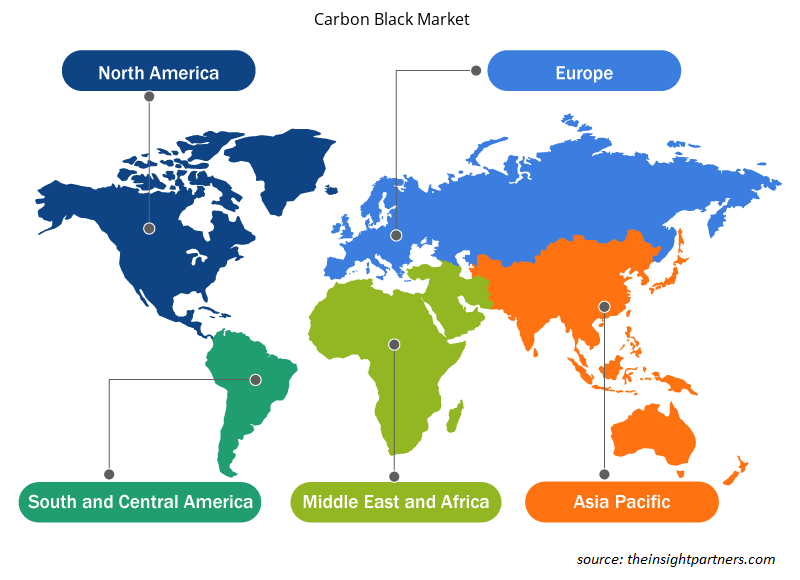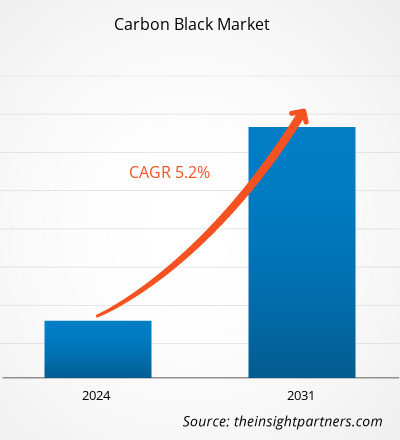Der Markt für Industrieruß wird voraussichtlich bis 2031 ein Volumen von 22,87 Milliarden US-Dollar erreichen, von 14,92 Milliarden US-Dollar im Jahr 2023, was einer durchschnittlichen jährlichen Wachstumsrate (CAGR) von 6,5 % im Prognosezeitraum entspricht. Die zunehmende Bedeutung des Altreifenmanagements dürfte weiterhin ein wichtiger Trend im Industrierußmarkt bleiben.
Carbon Black Marktanalyse
Die steigende Nachfrage aus der Automobilindustrie treibt das Marktwachstum maßgeblich voran. Ruß wird häufig zur Herstellung von Verstärkungs- und Pigmentphasen in Autoreifen verwendet, da er die Lebensdauer des Reifens durch die Reduzierung thermischer Schäden verlängert. Verschiedene Materialien, die bei der Reifenherstellung verwendet werden, gelten als wichtiger Faktor für Sicherheit und Komfort im Automobildesign. Ruß dient als Zusatzstoff im Gummi , der zur Herstellung von Reifen verwendet wird und dessen Zugfestigkeit und Abriebfestigkeit verbessert. Der Rußmarkt fördert die Gummi- und Autoreifenproduktion mit der weltweit steigenden Zahl an Automobilen.
Marktübersicht für Ruß
Die Partikelgröße von Ruß beeinflusst den Gummi und seine Farbeigenschaften. Kleinere Partikel haben eine größere Oberfläche und eine höhere Farbstärke. Ruß wird häufig zur Verstärkung von Reifengummi verwendet. Er kann außerdem als UV-Stabilisator, Pigment sowie Leit- und Isoliermittel in verschiedenen Kunststoff-, Gummi-, Tinten- und Beschichtungsanwendungen eingesetzt werden. Darüber hinaus ist Ruß für verschiedene Produkte in vielen Branchen unverzichtbar. Weitere Anwendungsgebiete von Ruß sind Schläuche, Förderbänder, Kunststoffe, Druckfarben und Autolacke.
Sie erhalten kostenlos Anpassungen an jedem Bericht, einschließlich Teilen dieses Berichts oder einer Analyse auf Länderebene, eines Excel-Datenpakets sowie tolle Angebote und Rabatte für Start-ups und Universitäten
Rußmarkt: Strategische Einblicke

-
Informieren Sie sich über die wichtigsten Markttrends in diesem Bericht.Dieses KOSTENLOSE Beispiel umfasst Datenanalysen, von Markttrends bis hin zu Schätzungen und Prognosen.
Treiber und Chancen auf dem Carbon Black-Markt
Steigende Nachfrage nach Spezialruß
Spezialruß ist die reinste Form von Industrieruß. Er enthält nur geringe Mengen an Schwefel, Metallen, Asche und anderen Verunreinigungen. Er wird durch die partielle Verbrennung von Kohlenwasserstoffen, einschließlich Öl und Gas, hergestellt, um strenge Spezifikationen zu erfüllen und die erforderliche Funktionalität gemäß den Endanwendungsanforderungen zu gewährleisten. Spezialruß findet Anwendung als Verstärkungsmittel in Riemen, Dichtungen, Schwingungsisolatoren, Schläuchen, Membranen , Buchsen, Fahrgestellstoßfängern, Luftfedern, Förderrädern und Gummitüllen. Darüber hinaus wird er auch in Müllsäcken, Industriebeuteln, Fotobehältern, Mulchfolien für die Landwirtschaft, Stretchfolien, thermoplastischen Formanwendungen für die Elektro-/Elektronik-, Automobil- und Blasformbehälter verwendet.
Steigender Bedarf an grünen Alternativen
Der Bedarf an grünen Alternativen steigt, wobei Nachhaltigkeit zunehmend im Mittelpunkt steht. Die grüne Wirtschaft fördert die wirtschaftliche Entwicklung, verbessert die Lebensqualität der Menschen und trägt gleichzeitig zum Umweltschutz bei. Grüner oder rückgewonnener Industrieruß (Ruß) etabliert sich als Alternative zu neuem Industrieruß, der durch die Verbrennung von Rohöl hergestellt wird. Ruß aus recycelten Reifen bietet zahlreiche Vorteile: Er trägt zu einer deutlichen Reduzierung der CO2-Emissionen bei und fördert die Wiederverwendung von Produkten zur Minimierung des Abfallaufkommens. Daher dürfte der steigende Bedarf an grünen Alternativen wie grünem oder rückgewonnenem Industrieruß weitere Marktwachstumsmöglichkeiten bieten.
Segmentierungsanalyse des Carbon Black-Marktberichts
Schlüsselsegmente, die zur Ableitung der Marktanalyse für Ruß beigetragen haben, sind Typ, Qualität und Anwendung.
- Der Markt für Ruß ist nach Typ in Acetylenruß, Kanalruß, Ofenruß, Thermalruß und andere unterteilt. Das Segment Ofenruß hatte im Jahr 2023 einen größeren Marktanteil.
- Nach Qualität ist der Markt in Standardqualität und Spezialqualität segmentiert. Das Segment Standardqualität hatte im Jahr 2023 den größten Anteil am Rußmarkt.
- Hinsichtlich der Anwendung ist der Markt in Reifen, Nicht-Reifengummi, Kunststoffe, Tinten und Beschichtungen und andere segmentiert. Das Reifensegment dominierte den Markt im Jahr 2023.
Ruß-Marktanteilsanalyse nach geografischer Lage
Der geografische Umfang des Marktberichts für Ruß ist hauptsächlich in fünf Regionen unterteilt: Nordamerika, Asien-Pazifik, Europa, Naher Osten und Afrika sowie Süd- und Mittelamerika.
Der asiatisch-pazifische Raum dominiert den Rußmarkt. Im asiatisch-pazifischen Raum treiben Faktoren wie die wachsende Automobil-, Lack- und Reifenindustrie das Marktwachstum maßgeblich voran. Das hohe verfügbare Einkommen der Bevölkerung in der Region führt zu einer steigenden Nachfrage nach Pkw und Nutzfahrzeugen und erhöht damit den Bedarf an Autoreifen. Die steigende Nachfrage nach Elektrofahrzeugen im asiatisch-pazifischen Raum und die steigenden Investitionen führender Automobilhersteller treiben das Marktwachstum zusätzlich voran. Das Wachstum der Reifenindustrie in der Region ist zudem auf das Wachstum der Automobilindustrie zurückzuführen.
Regionale Einblicke in den Rußmarkt
Die Analysten von Insight Partners haben die regionalen Trends und Faktoren, die den Rußmarkt im Prognosezeitraum beeinflussen, ausführlich erläutert. In diesem Abschnitt werden auch die Marktsegmente und die geografische Lage in Nordamerika, Europa, Asien-Pazifik, dem Nahen Osten und Afrika sowie Süd- und Mittelamerika erörtert.

- Erhalten Sie regionale Daten zum Rußmarkt
Umfang des Marktberichts zu Ruß
| Berichtsattribut | Details |
|---|---|
| Marktgröße im Jahr 2023 | 14,92 Milliarden US-Dollar |
| Marktgröße bis 2031 | 22,87 Milliarden US-Dollar |
| Globale CAGR (2024 – 2031) | 6,5 % |
| Historische Daten | 2021-2022 |
| Prognosezeitraum | 2024–2031 |
| Abgedeckte Segmente |
Nach Typ
|
| Abgedeckte Regionen und Länder |
Nordamerika
|
| Marktführer und wichtige Unternehmensprofile |
|
Marktdichte von Carbon Black: Auswirkungen auf die Geschäftsdynamik
Der Markt für Industrieruß wächst rasant. Die steigende Endverbrauchernachfrage ist auf Faktoren wie veränderte Verbraucherpräferenzen, technologische Fortschritte und ein stärkeres Bewusstsein für die Produktvorteile zurückzuführen. Mit der steigenden Nachfrage erweitern Unternehmen ihr Angebot, entwickeln Innovationen, um den Verbraucherbedürfnissen gerecht zu werden, und nutzen neue Trends, was das Marktwachstum weiter ankurbelt.
Die Marktteilnehmerdichte beschreibt die Verteilung der in einem bestimmten Markt oder einer bestimmten Branche tätigen Unternehmen. Sie gibt an, wie viele Wettbewerber (Marktteilnehmer) in einem bestimmten Marktraum im Verhältnis zu dessen Größe oder Gesamtmarktwert präsent sind.
Die wichtigsten auf dem Rußmarkt tätigen Unternehmen sind:
- HiiROC Ltd
- Black Bear Carbon BV
- Klean Industries Inc.
- Delta Energy LLC
- OMSK Carbon Group Ltd
- Imerys SA
Haftungsausschluss : Die oben aufgeführten Unternehmen sind nicht in einer bestimmten Reihenfolge aufgeführt.

- Überblick über die wichtigsten Akteure auf dem Carbon Black-Markt
Neuigkeiten und aktuelle Entwicklungen zum Carbon Black-Markt
Der Rußmarkt wird durch die Erhebung qualitativer und quantitativer Daten aus Primär- und Sekundärforschung bewertet. Dazu zählen wichtige Unternehmenspublikationen, Verbandsdaten und Datenbanken. Nachfolgend finden Sie eine Liste der Entwicklungen im Markt für Sprachstörungen und Strategien:
- Die Cabot Corporation (NYSE: CBT) gab die Markteinführung von VULCAN 3-LP Carbon Black bekannt, einem neuen Produkt mit niedrigem Gehalt an polyzyklischen aromatischen Kohlenwasserstoffen (PAK) für Gummianwendungen. VULCAN 3-LP Carbon Black ist das vierte Produkt der Cabot LP Carbon Black-Serie und bietet Kunden eine umfassende Palette an Carbon Black-Produkten für Anwendungen, die einen kontrollierten, sehr niedrigen PAK-Gehalt erfordern, wie beispielsweise Konsumgüter aus Gummi sowie Anwendungen im Lebensmittel- und Trinkwasserbereich. (Quelle: Cabot Corporation, Pressemitteilung/Unternehmenswebsite/Oktober 2021)
- Birla Carbon, der führende Anbieter nachhaltiger Kohlenstofflösungen, gab die Eröffnung zweier neuer Produktionsstätten für Industrieruß in Naidupet, Andhra Pradesh, Indien, und Rayong, Thailand, bekannt. (Quelle: Birla Carbon, Blogs/Unternehmenswebsite/Januar 2024)
Marktbericht zu Ruß – Umfang und Ergebnisse
Der Bericht „Marktgröße und Prognose für Ruß (2021–2031)“ bietet eine detaillierte Analyse des Marktes, die die folgenden Bereiche abdeckt:
- Marktgröße und Prognose auf globaler, regionaler und Länderebene für alle wichtigen Marktsegmente, die im Rahmen des Berichts abgedeckt sind
- Marktdynamik wie Treiber, Hemmnisse und wichtige Chancen
- Wichtige Zukunftstrends
- Detaillierte Porter's Five Forces und SWOT-Analyse
- Globale und regionale Marktanalyse mit wichtigen Markttrends, wichtigen Akteuren, Vorschriften und aktuellen Marktentwicklungen
- Branchenlandschaft und Wettbewerbsanalyse, einschließlich Marktkonzentration, Heatmap-Analyse, prominenten Akteuren und aktuellen Entwicklungen
- Detaillierte Firmenprofile
- Historische Analyse (2 Jahre), Basisjahr, Prognose (7 Jahre) mit CAGR
- PEST- und SWOT-Analyse
- Marktgröße Wert/Volumen – Global, Regional, Land
- Branchen- und Wettbewerbslandschaft
- Excel-Datensatz
Aktuelle Berichte
Erfahrungsberichte
Grund zum Kauf
- Fundierte Entscheidungsfindung
- Marktdynamik verstehen
- Wettbewerbsanalyse
- Kundeneinblicke
- Marktprognosen
- Risikominimierung
- Strategische Planung
- Investitionsbegründung
- Identifizierung neuer Märkte
- Verbesserung von Marketingstrategien
- Steigerung der Betriebseffizienz
- Anpassung an regulatorische Trends






















 Kostenlose Probe anfordern für - Markt für Ruß
Kostenlose Probe anfordern für - Markt für Ruß